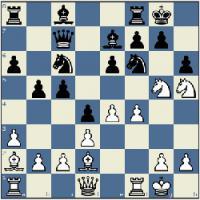
Why not 2.f4 in the Grand Prix Attack?
The masters of the game said that 2.f4 is wrong when playing the Grand Prix Attack (GPA) and the correct move is 2.Nc3 which is also termed Closed Sicilian. Well, I'm no master of the game but one who happened to enjoy playing chess and I love the move 2.f4 every time. The only exception is when black threatens to take my e4 pawn after the first move like in the Scandinavian or the Alekhine Defence.
The move 2.f4 is the original Grand Prix Attack or McDonnell Attack which first appeared in 1834 in a game between Alexander McDonnell and Charles Louis Mahé de La Bourdonnais. Unfortunately for the opening, its debut was a loss. However the actual reason for the decline of 2.f4 is because Michael Tal came up with his gambit 2...d5 3.exd5 Nf6! I like Tal because he was an aggressive player who once said "there are two types of sacrifices: correct ones and mine." I see myself in him because of his sacrifices - the only difference is that his were often brilliant while mine are often questionnable or unsound.
 Since it's not Tal that I'm playing against why not 2.f4? After 2...d5, I don't feel I am forced to move 3.exd5, instead I prefer 3.Nc3. However, the opening books have not given their analysis on this line. Is it because it is obviously wrong or contradictory to the chess rules? For the masters perhaps it is obvious but not for me and the likes of me who I get the chance to play with most of the time.
Since it's not Tal that I'm playing against why not 2.f4? After 2...d5, I don't feel I am forced to move 3.exd5, instead I prefer 3.Nc3. However, the opening books have not given their analysis on this line. Is it because it is obviously wrong or contradictory to the chess rules? For the masters perhaps it is obvious but not for me and the likes of me who I get the chance to play with most of the time.
The game below is in Caro-Kann Defence but was transposed to GPA. The position after 14.Nh5 as shown on the image above had been reached in many of my 2.f4 games where the intention is to sac the knight on g5. White wins almost everytime black accepts the sacrifice. The position occurred more frequently in the Sicilian Defence, when black moves d4 instead of dxe4. The only difference in position after 14.Nh5 is that black's light-squared bishop is already on b7. Caro-Kann lost one tempo in c6 and c5 moves instead of the direct c5 in Sicilian. The same position had also been reached many times in the Pelikan Variation of the French Defence with the same bishop on b7 as the only deviation. The bishop's position however does not change the outcome. Checkmate! 
There are also a few traps that I learned in playing this kind of GPA. Since I joined chess.com last month, I have the following short games where I was lucky enough that my opponents were already tired and were no longer paying attention on the traps.
